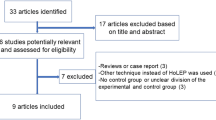Abstract
Purpose
To examine the complications and functional outcomes of high-risk patients on antithrombotic therapy (ATT) treated with photoselective vaporization of the prostate (PVP) using the Greenlight (GL) XPS-180 system.
Methods
A retrospective analysis of prospectively maintained institutional database was performed. Men with symptomatic LUTS related to BPH were treated with 523-nm GL PVP using the XPS-180 W system. They were stratified according to ATT status: group 1 (control group), group 2 (acetylsalicylic acid), group 3 (antiplatelet agents other than acetylsalicylic acid) and group 4 (anticoagulation agents). Postoperative adverse events at 30- and 90-days were prospectively recorded. Complications were stratified according to the Clavien-Dindo classification. Additionally, functional outcomes (IPSS, Qmax and PVR) were analyzed up to 48 months of follow-up after surgery. Multivariable logistic regression analyses were used to predict the effect of ATT on serious bleeding-associated complications that was defined as the sum of patients with hematuria Clavien grade ≥ 2, patients requiring transfusions and patient with postoperative hemoglobin drop ≥ 15 g/dl.
Results
274 (63%), 87 (21%), 24 (6%) and 37 (9%) patients were included in groups 1, 2, 3 and 4, respectively. Patients on antiplatelet (group 3) and anticoagulant medication (group 4) were older (median age 60 vs. 68 vs. 77 vs. 76 years, p < 0.001) and had more comorbidities (ASA 3–4: 9.5 vs. 27.6 vs. 66.7 vs. 64.9%; p < 0.001) than their counterparts. The overall 30-day complications rates were 31, 28.7, 45.8 and 45.9% of patients included in groups 1, 2, 3 and 4, respectively (p = 0.4). Hematuria Clavien 1 events (p < 0.001), readmissions rates (p = 0.02), length of post-operative hospital stay (p < 0.001) and catheterization time (p < 0.001) were significantly higher in patients on antiplatelet and anticoagulation medication. In multivariable analyses, ATT status was not a predictor of serious bleeding events after surgery (p > 0.5). Finally, functional outcomes were significantly improved accross the four groups.
Conclusion
GL PVP is safe and effective in treating high-risk patients on ATT. Although serious bleeding complications are rare and equivalent with non-high-risk patients, patients on antiplatelet and anticoagulation medication should be counseled on the increased risk of minor bleeding events and readmissions rates at 30 days after surgery.

Similar content being viewed by others
References
Gratzke C, Bachmann A, Descazeaud A et al (2015) EAU guidelines on the assessment of non-neurogenic male lower urinary tract symptoms including benign prostatic obstruction. Eur Urol 67:1099–1109
McVary KT, Roehrborn CG, Avins AL et al (2011) Update on AUA guideline on the management of benign prostatic hyperplasia. J Urol 185:1793–1803
Thomas JA, Tubaro A, Barber N et al (2016) A multicenter randomized noninferiority trial comparing GreenLight-XPS laser vaporization of the prostate and transurethral resection of the prostate for the treatment of benign prostatic obstruction: two-yr outcomes of the GOLIATH study. Eur Urol 69:94–102
Herrmann TR, Liatsikos EN, Nagele U, Traxer O, Merseburger AS (2012) Guidelines on lasers and technologies. Eur Urol 61(4):783–795
Chung DE, Wysock JS, Lee RK et al (2011) Outcomes and complications after 532 nm laser prostatectomy in anticoagulated patients with benign prostatic hyperplasia. J Urol 186:977–981
Knapp GL, Chalasani V, Woo HH (2017) Perioperative adverse events in patients on continued anticoagulation undergoing photoselective vaporisation of the prostate with the 180-W Greenlight lithium triborate laser. BJU Int 119(Suppl 5):33–38
Lee DJ, Rieken M, Halpern J et al (2016) Laser vaporization of the prostate with the 180-W XPS-Greenlight laser in patients with ongoing platelet aggregation inhibition and oral anticoagulation. Urology 91:167–173
Ruszat R, Wyler S, Forster T et al (2007) Safety and effectiveness of photoselective vaporization of the prostate (PVP) in patients on ongoing oral anticoagulation. Eur Urol 51:1031–1038 (discussion 8–41)
GreenLight XPS for treating benign prostatic hyperplasia: (c) NICE (2016) (2017) GreenLight XPS for treating benign prostatic hyperplasia. BJU Int 119:823–830
Nickel JC, Herschorn S, Corcos J et al (2005) Canadian guidelines for the management of benign prostatic hyperplasia. Can J Urol. 12:2677–2683
Zorn KC, Liberman D (2011) GreenLight 180 W XPS photovaporization of the prostate: how I do it. Can J Urol 18:5918–5926
Valdivieso R, Meyer CP, Hueber PA et al (2016) Assessment of energy density usage during 180 W lithium triborate laser photoselective vaporization of the prostate for benign prostatic hyperplasia. Is there an optimum amount of kilo-Joules per gram of prostate? BJU Int 118:633–640
Mitropoulos D, Artibani W, Graefen M et al (2012) Reporting and grading of complications after urologic surgical procedures: an ad hoc EAU guidelines panel assessment and recommendations. Eur Urol 61:341–349
Macchione L, Mucciardi G, Gali A et al (2013) Efficacy and safety of prostate vaporesection using a 120-W 2-μm continuous-wave Tm:YAG laser (RevoLix 2) in patients on continuous oral anticoagulant or antiplatelet therapy. Int Urol Nephrol 45:1545–1551
Elzayat E, Habibi E, Elhilali M (2006) Holmium laser enucleation of the prostate in patients on anticoagulant therapy or with bleeding disorders. J Urol 175:1428–1432
Author information
Authors and Affiliations
Corresponding author
Rights and permissions
About this article
Cite this article
Meskawi, M., Hueber, PA., Valdivieso, R. et al. Complications and functional outcomes of high-risk patient with cardiovascular disease on antithrombotic medication treated with the 532-nm-laser photo-vaporization Greenlight XPS-180 W for benign prostate hyperplasia. World J Urol 37, 1671–1678 (2019). https://doi.org/10.1007/s00345-018-2560-8
Received:
Accepted:
Published:
Issue Date:
DOI: https://doi.org/10.1007/s00345-018-2560-8




